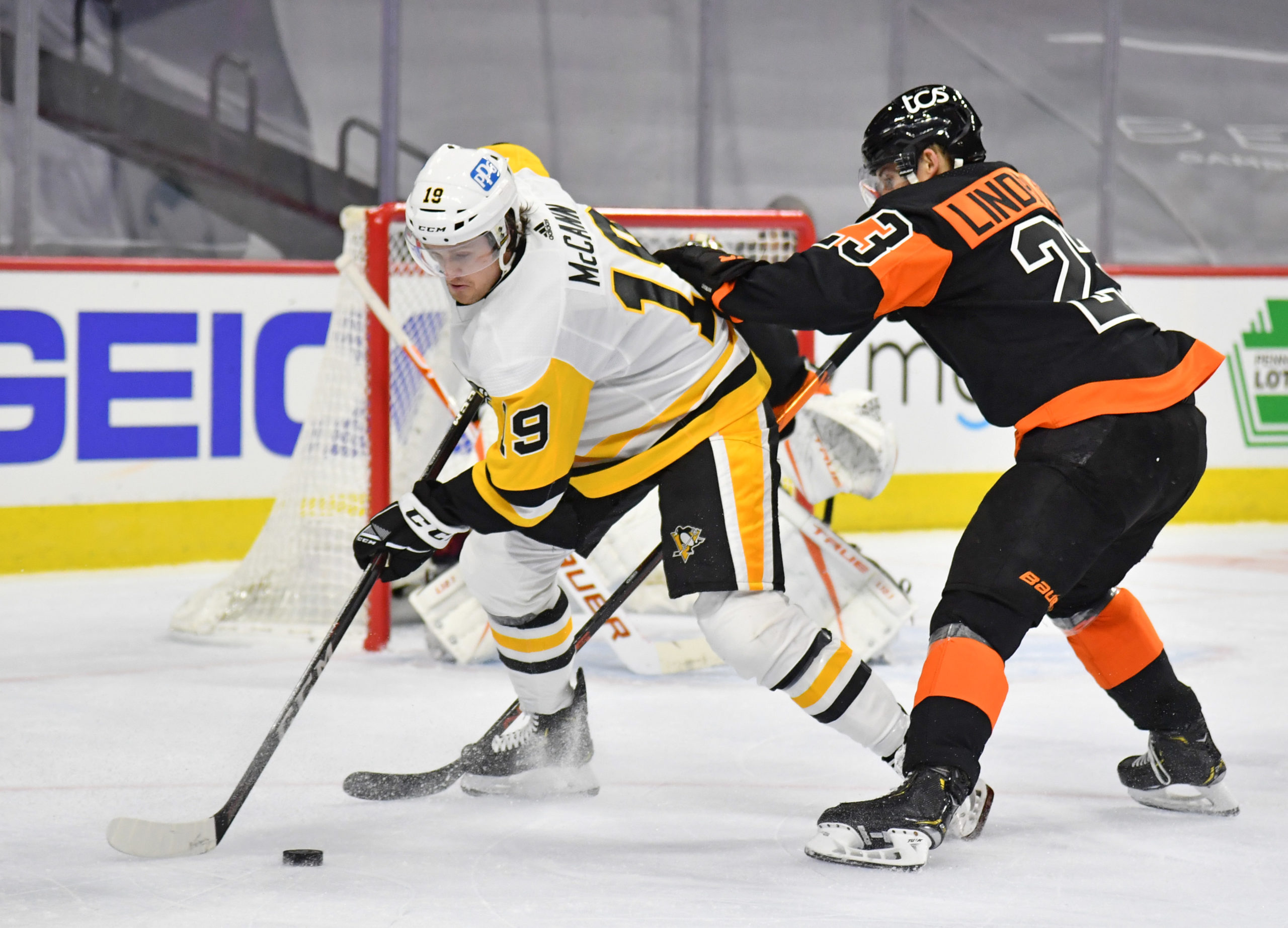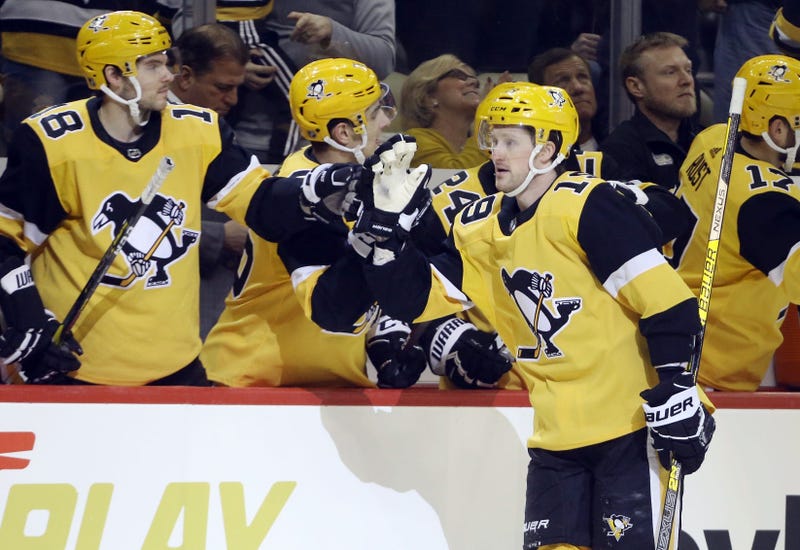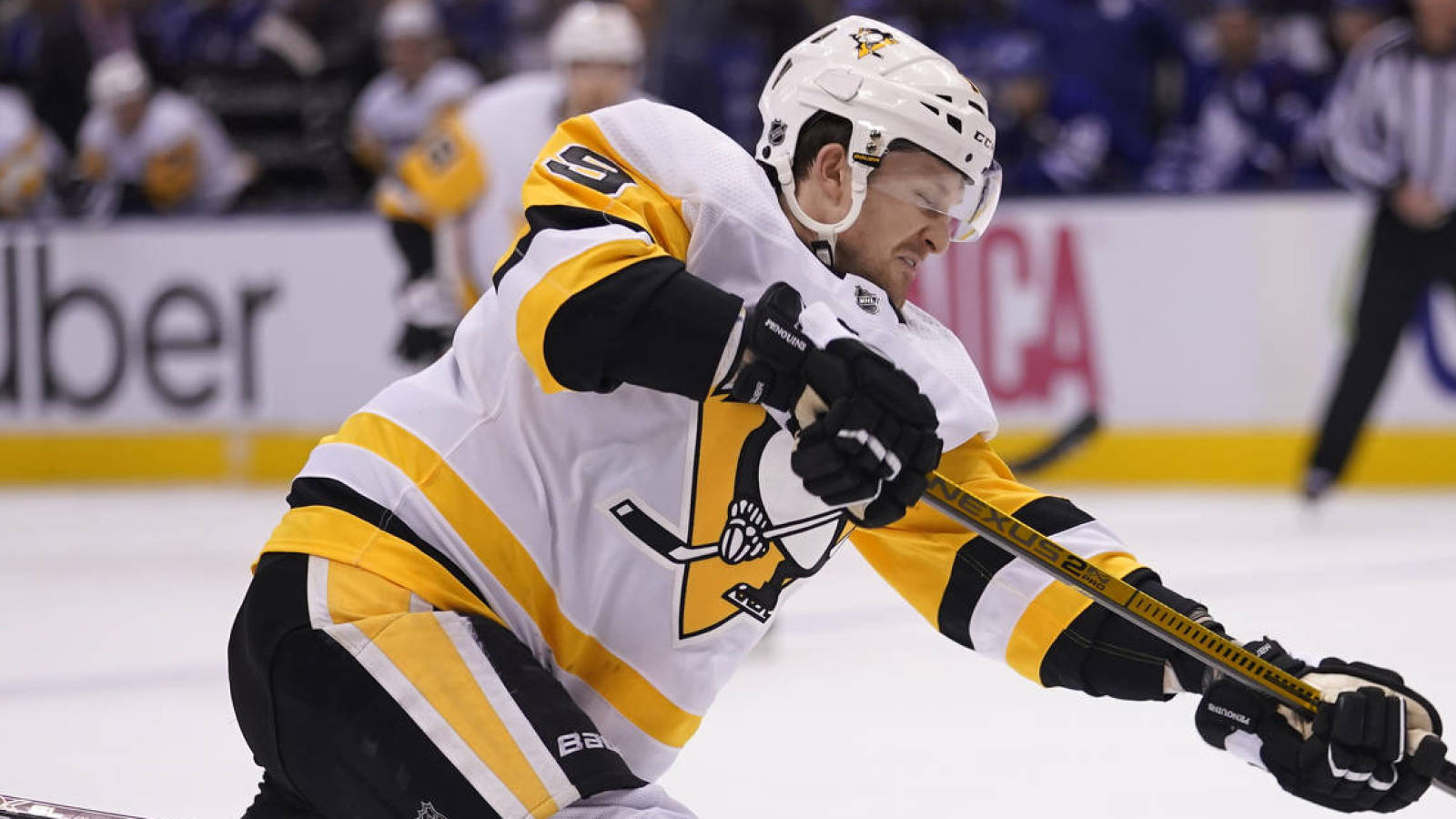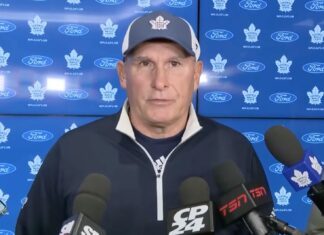At 2:50 pm ET, many of us were lamenting the NHL as the most boring league on the planet. Adin Hill was the big move of the day with just 10 minutes until the expansion-imposed trade deadline.
Boy, were we ever mistaken.
Ryan Ellis went to the Flyers in a three-way trade that sent Nolan Patrick to the Golden Knights and Cody Glass and Philippe Myers to the Predators. Jason Dickinson moved to Vancouver, Andrew Ladd’s contract landed in Arizona, Brett Howden headed to Vegas, and the rights to Barclay Goodrow went to New York. We even learned that Carey Price and Vladimir Tarasenko were exposed in the expansion draft.
However, since Toronto is the center of the hockey universe, the story of the day was the Jared McCann trade. I’ve wanted the Leafs to trade for him for ages, as I tweeted here, here, here, here, here, and here. I see this as a low-risk move with some potential reward.
The Trade for Jared McCann

This trade was a bit of a no-brainer. Frankly, I can’t believe the Leafs only gave up Filip Hallander and a seventh. McCann’s $2.94 million cap hit is good value, and he’ll be a restricted free agent next offseason. He finished second (!) to Connor McDavid in Evolving Hockey’s goals above replacement (GAR) statistic last season, and while he’s obviously not the second-best player in the NHL, he’s been an underrated player for a while now. I am quite surprised that Pittsburgh decided not to keep and protect him in the expansion draft. I’d like the trade even if the Leafs exposed McCann in the expansion draft — giving up Hallander and a seventh in this process isn’t all that much.
McCann could be used as a top-six winger or a third-line center. He scored 32 points in 43 games last season, which equals a 61-point pace over 82 games. It’s not like he was a complete one-year wonder, either, as he surpassed the 0.5 points-per-game mark last season as well. As I tweeted here, when the news first broke last offseason that Kapanen was headed to Pittsburgh, I was hoping that it was McCann who was coming the other way. The Leafs now have both McCann and Rodion Amirov for Kasperi Kapanen and a seventh.
McCann played for both Sheldon Keefe and Kyle Dubas on the Soo Greyhounds, so there’s plenty of familiarity here. Rhys Jessop actually interviewed Dubas about McCann for CanucksArmy.com back in 2014 in an article you can find here. He’s 6’1″, from Stratford, and only 25. Expect him to be somewhere between 43%-48% in the face-off circle, but if they want to use him at center, they could always pair him with a right-handed option like Jason Spezza or William Nylander.
McCann played just 11 minutes with Crosby last season at 5-on-5 and just 35 minutes with Malkin. His primary linemates (in order) were Jason Zucker, Jeff Carter, Evan Rodrigues, and Kasperi Kapanen (who he fought back in 2020). In his previous season with Pittsburgh, his primary linemates were Dominik Kahun, Patric Hornqvist, and Dominik Simon. While he did get some time on Pittsburgh’s top power-play unit, this isn’t a case of a player having inflated production due to Crosby and Malkin.
McCann scored 2.4 points per 60 minutes at 5-on-5 last season, which would have ranked fourth on the Leafs behind Mitch Marner, Auston Matthews, and Jason Spezza. He ranked eighth in the NHL in primary assists per minute at 5-on-5 behind McDavid, MacKinnon, Spezza, Panarin, Robertson, Marner, and Stone (minimum 400 minutes). While he’s unlikely to produce those numbers again, he did score 1.77 points per 60 minutes at 5-on-5 in the 2019-20 season, which is still quite strong.
If we take a three-year sample, he’s scored 1.79 points per 60 minutes at 5-on-5, which puts him just ahead of players like Connor Brown, Blake Coleman, Andreas Johnsson, and Tyler Toffoli. Ultimately, he’s someone who can bring plenty of secondary scoring to the table, even when he’s not playing with star linemates. If he does play on the wing, I’m curious to see what he could do with either Matthews and Marner or Tavares and Nylander.
McCann was a late first-round pick back in 2014. Surprisingly, he made the Vancouver Canucks as a 19-year old a year later. Following his rookie season, he was then traded to Florida as part of a deal for Erik Gudbranson. Given how young he was when he made the NHL, I’ve always felt that many have underrated his potential. His NHL experience made everyone think that he’s older than he really is.
There is one main callout with McCann. Out of the 331 forwards who played 400+ minutes at 5-on-5 last season, he finished fourth in on-ice shooting percentage at 13.27%. That’s certainly unsustainable and helps to explain why his 5-on-5 production was through the roof last season. Seven of his 14 goals were scored on the power play, and his point production should fall a bit next season if he plays in a similar role. However, it’s not like the Leafs were “buying high” here. Even if he ends up resembling prime Andreas Johnsson (not last year’s version), McCann is worth it.
Leafs acquire Jared McCann who will probably regress from last season’s incredible output, but should still be an extremely useful piece on a very cheap deal. Projects as second line caliber. pic.twitter.com/YzmXNkLAvl
— dom at the athletic (@domluszczyszyn) July 17, 2021
The Scouting Report on Jared McCann

McCann boasts a powerful wrist shot, which he uses quite often. He can beat goalies from medium-danger scoring areas, and frankly, this is something the Leafs have lacked in recent seasons. Everyone looks at Auston Matthews and thinks the Leafs are a great shooting team, but Toronto had plenty of weaker shots in their lineup last season, including Thornton, Marner, Hyman, Kerfoot, Mikheyev, and even Simmonds.
I was always a bit confused when McCann posted a low shooting percentage in his first three NHL seasons, but he’s now shot 15% in two of his last three seasons.
As mentioned above, he racked up a ton of primary assists last season, so it’s quite clear that his wrist shot isn’t his only offensive weapon. There’s a bit of grit to his game, as he’s not afraid to drop the gloves every now and then and he’s fairly good at getting to the dirty areas. He’s a left-shooting forward who typically plays on his non-one-timer side on the power play, where his wrist shot can be a fine weapon.
The knock on McCann offensively is that he’s not elite in any one area. His shot is slightly above average, but it’s not worth writing home about. He’s a good skater rather than a great skater. He’s a solid forechecker, but he’s not quite Zach Hyman. He’s a fine playmaker and puck carrier, but no one is going to confuse him for Mitch Marner or William Nylander. I don’t think he’s a first-line player, but I see him as a reasonable second-line option or a high-end third-line option.
There is plenty to like about his versatility. While he’s played primarily on the wing, he did play center for Sheldon Keefe with the Greyhounds and has also spent a fair amount of time playing up the middle at the NHL level. He can play on your second power-play unit, and while he didn’t kill penalties this season, he could take some minutes there if needed. The Leafs could play him at left wing on one of the top two lines, or use him as the third-line center. He could also play on the wing of a checking line if needed, or play on the left-side across from Jason Spezza. His well-rounded skill set makes him a fit just about anywhere.
McCann graded out extremely well by Evolving Hockey’s RAPM this year. His high on-ice shooting percentage inflated his on-ice impact on goals for, but it’s worth noting that his impact on expected goals for was quite strong as well. While he hasn’t always been a major driver of expected goals for, he consistently grades out above average defensively.
An Advanced Stats God

As mentioned above, McCann finished second in Evolving Hockey’s Goals Above Replacement (GAR) this season behind only Connor McDavid, thanks largely to a very high on-ice shooting percentage. After an outlier season, it would be a surprise if he was even in the top 20 anytime soon. However, McCann’s graded out well by the more advanced numbers for quite some time now.
I looked at a three-year sample and excluded McCann’s big season last year. Between the 2017-18 season and the 2019-20 season, McCann ranks ahead of Hyman in GAR. Again, we’re not even including his big 2021 season here. While Hyman has a clear edge in terms of 5v5 offense during this time, McCann grades out as better defensively and gets credit for drawing a fair amount of penalties without taking many.
In terms of expected goals above replacement (xGAR), McCann carries a slight edge in the most recent three-year sample. Hyman carries a clear edge if you look at a larger sample, but McCann has him beat in back-to-back seasons. Once again, while Hyman carries a clear edge in terms of 5v5 offense, McCann is better defensively, better on the power play, and picks up value for his penalty differential.
Perhaps McCann isn’t quite as good as Hyman. Frankly, if the salaries were equal, I’d take Hyman over McCann fairly quickly. Having said that, is the gap between the two closer than we think? Probably. McCann carries a $2.94 million cap hit for next season, and if it doesn’t work out, the Leafs can just walk away without offering him a qualifying offer. If he plays well, his qualifying offer would be for around $3.4 million (what they gave Johnsson), and they could look to sign him long-term. If he racks up plenty of points in the top six, there’s also a chance that the Leafs could look to trade him for a fairly significant return next offseason.
Final Thoughts

McCann grades out extremely well by the numbers over the last two seasons. If he’s anywhere close to as good as those numbers suggest, the Leafs have a steal. Even if it doesn’t work out all that well, I still expect him to be somewhat similar to Kerfoot — a reasonable middle-six forward who is pretty much worth his cap hit. I see this as a low-risk move with a reasonably high reward.
Hallander’s a fine prospect, but he scored just 24 points in 51 games last season for Lulea of the Swedish Hockey League. After watching him play in a few of those games, while I like his two-way game, I don’t see a ton of offensive upside. Ultimately, you’d be thrilled if he turned into something close to Jared McCann. The odds are certainly against him ever getting a $3 million contract.
I really don’t understand this trade from the Penguins’ point of view. Trading McCann now means that they’ll lose someone like Zach Aston-Reese or Tristan Jarry, both of which should have more value than Hallander and a seventh. I don’t get it at all. I also don’t understand why they’d ever part ways with Cheddar McCann.
leafs fans: the most important part of this trade is that you gained Cheddar McCann, who absolutely rules. pic.twitter.com/xVG8GXX0Qb
— katie (@dameofscones) July 17, 2021
I’m curious to see what this means for Toronto’s expansion protection list. There is at least an outside chance that they exposed McCann and still protected four defensemen — giving up Hallander and a seventh in this process wouldn’t be all that much — but I expect that they have protected seven forwards and three defensemen. I wonder if they’d rather lose Kerfoot than Dermott or Holl, and if so, maybe they exposed Kerfoot to give Seattle the chance to take him. If that’s the case, the last forward protection spots don’t really matter. They could end up protecting players like Spezza and Simmonds, even though Seattle wouldn’t have taken them anyway.
Assuming he’s not exposed (and taken) in the expansion draft, I’m also curious to see what the Leafs’ plan is for McCann. Do they see him starting as a center or a winger? If they’re comfortable with him in both roles, they should have more flexibility this offseason. If you can sign someone like Alex Wennberg or Nick Bonino for a bargain price, you could shift him over to the wing. If you can add a winger like Tomas Tatar or Brandon Saad for a reasonable price, you could play McCann up the middle. If you keep Kerfoot as well, you could rotate the two of them back and forth between center and the wing to see what works best. There are plenty of possibilities here.
Frankly, I expect Kerfoot to play elsewhere next season. Assuming the Leafs have one spare player on the roster, they have about $5.5 million remaining for a second goalie and an impact forward. If Holl or Dermott are taken in the expansion draft, it’s going to be tough to replace them for less. I’ll take McCann at $2.94 million over Kerfoot at $3.5 million. My guess is that they see him as Kerfoot’s replacement and will use the extra $500k or so to help add a top-six forward and a 1B goalie option.
All in all, this trade was a tidy piece of business for the Maple Leafs.

































